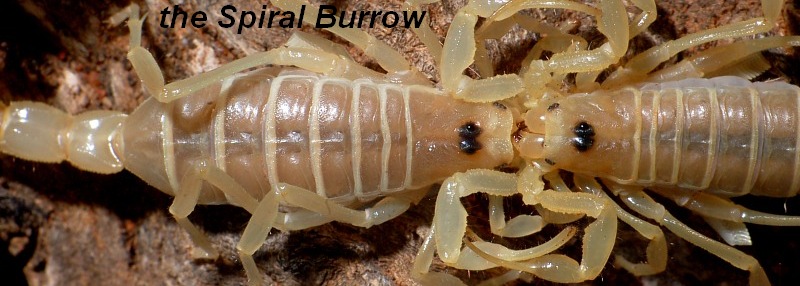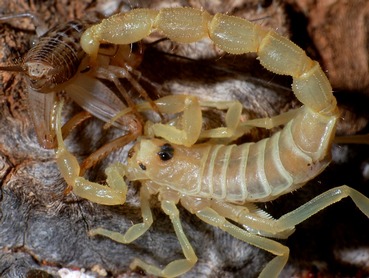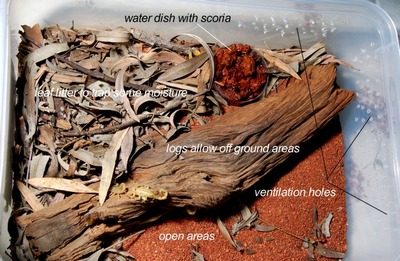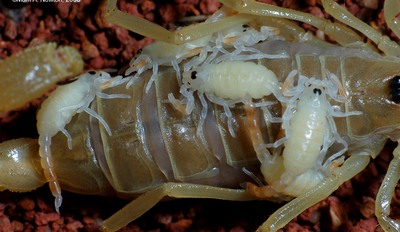
Husbandry - Australobuthus xerolimniorum
The Salt Lake Scorpion is a small species (45mm) found active on a warm summers night on any one of South Australia's inland salt lakes. They normally take daytime refuge in amongst shoreline vegetative litter or hide in cracks. When darkness comes they take to the salt surface and actively forage until a food item such as a resting fly is found. They generally remain still until the meal is finished before off hunting again if still hungry. They have been found up to 250 metres or more off shore, but generally most forage inside 10-30m.
We are lucky in that this incredibly interesting and unique species is relatively easy to maintain in captivity. My tests show that this animal loses water to evaporation at about 1/3 of the rate Lychas buchari loses water, although this figure varies between forms, some being hardier than others. Scorpions that are good at retaining water are always the easiest to keep, they are not as fussy as the others and as a result, it is a lot easier to find a suitable housing method. They are not however without potential problems. As with all desert Buthids, mycosis(fungal infections) need to be avoided as they are readily susceptible, so much so, that it is not uncommon to find individuals in the wild with mild cases.
 |
the Salt Lake ScorpionAustralobuthus xerolimniorum is a very unusual species of scorpion that has successfully adapted to the harsh and volatile inland salt lakes of South Australia. Rarely larger than 45mm this species can be found foraging as far as 250m offshore, motoring at a fast past in order to seek and disturb resting invertebrates. |
Housing and Conditions: I use bone dry soil and a shallow dish filled with washed scoria and water. The water is available for the scorpion to drink and bumps humidity up a little. I think it is wise to have a lid on your housing with some ventilation. I drill many holes into the walls of one end up to about 1/3 the length of the housing. If ventilation is not adequate your scorpion might develop mycosis. Mycosis can be recognised as dark spots or patches where the integument is being eaten; eventually it will move inside and kill the scorpion. The feet and legs area are common spots for infection, along with the pectines. Baking the soil in the oven or microwaving is an effective method for killing fungal spores as those responsible seem to be soil borne. Dry soil will also help to keep any mite population under control. Mites can become a problem, if they are seen accumulating on your scorpions it will be necessary to bake fresh soil and start again. Do your best to remove as many mites as possible from the scorpion, placing the scorpion under water and using a small paint brush is an effective way to remove mites.
 |
HousingThe best system is just about always the False Bottom System, explained on the U. yaschenkoi husbandry page, but it's not always practical. Keeping in small tubs as shown is quite a good option as long as a vigilant watch is kept as smaller housings are less forgiving. Good ventilation, dry substrate, stone filled water dish and plenty of leaf litter with wood or rocks to allow the scorpion places to get off the substrate. |
I have found they get along quite well in a group, but the possibility of a gravid female consuming others exists. One way to avoid this is to keep them all well fed and give them plenty of off-substrate places to sit. Very little of anything else is needed; they tend to prefer to sit out in the open in my experience and as long as they are kept out of sunlight this should be the case. The difficulty arises with gravid females nearing parturition and young instars. You will need to bump up humidity at some stage if you have a gravid female as a successful parturition will not take place if the air is dry. She will most likely construct a scrape in open soil as preparation. When you can clearly see embryos through her pleural membrane its time to increase the relative humidity. Reduce the degree of ventilation and fill the water dish. I advise you use sticky tape over a drilled hole to add water and feed as removing the lid will diminish humidity. Removing the tape momentarily will have little effect on humidity. Covering ventilation holes with tape will increase humidity. Keep the scorpion between 25-30C.
 |
Vagile 1st Instars1st instars of this species are quite vagile which may be a reflection of unsuitable conditions; they are nearly completely white with some orange on the hands and tail. |
Sexing
Not easy. Look for the usual signs of larger body size in the female, the females are generally quite a bit larger than the males in this species. The only other real sexually dimorphic character is in the length of the pectines, in which the males are longer, but this is not easy as they are very long in both sexes, as many as 40 teeth on each side. Otherwise hand shape and tail are much the same between the two. There appears to be no sexual sting and little if any aggression between the sexes.